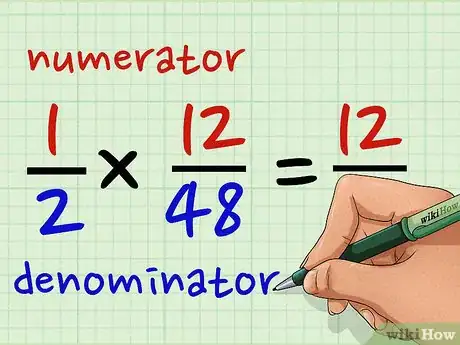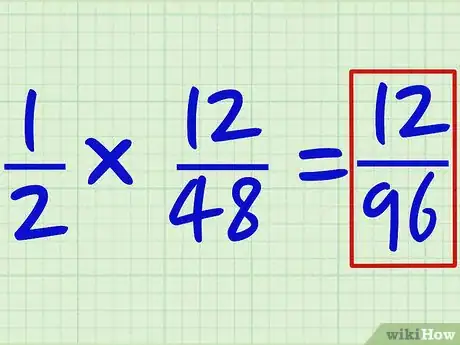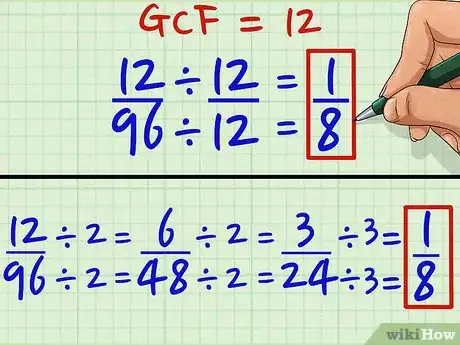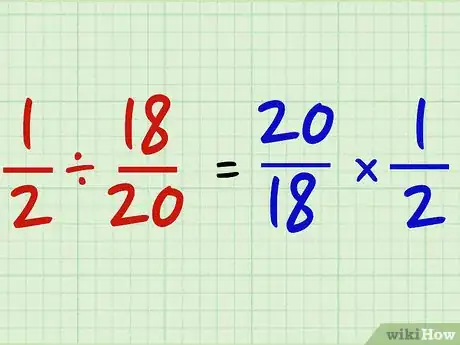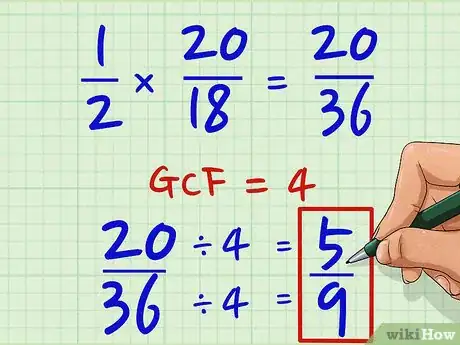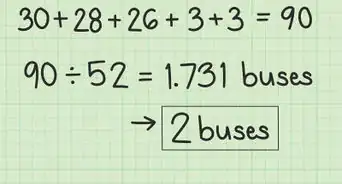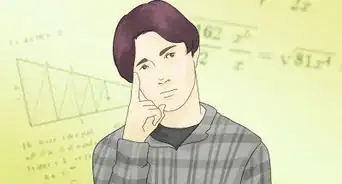This article was co-authored by Mario Banuelos, PhD. Mario Banuelos is an Assistant Professor of Mathematics at California State University, Fresno. With over eight years of teaching experience, Mario specializes in mathematical biology, optimization, statistical models for genome evolution, and data science. Mario holds a BA in Mathematics from California State University, Fresno, and a Ph.D. in Applied Mathematics from the University of California, Merced. Mario has taught at both the high school and collegiate levels.
There are 8 references cited in this article, which can be found at the bottom of the page.
wikiHow marks an article as reader-approved once it receives enough positive feedback. This article received 13 testimonials and 92% of readers who voted found it helpful, earning it our reader-approved status.
This article has been viewed 499,805 times.
To multiply fractions, all you have to do is multiply the numerators and denominators and simplify the result. To divide fractions, you simply have to flip the numerator and denominator of one of the fractions, multiply the result by the other fraction, and simplify. If you want to know how to divide and multiply fractions in no time at all, just follow these steps.
Steps
Multiplying Fractions
-
1Multiply the numerators of the fractions. The numerator is the number on the top of a fraction and the denominator is the number on the bottom.[1] The first step to multiplying fractions is to line them up so that their numerators and denominators are next to each other.[2] If you're multiplying the fraction 1/2 by 12/48, then the first thing you want to do is multiply the numerators, 1 and 12. 1 x 12 = 12. Write the product, 12, in the numerator of the answer.[3]
-
2Multiply the denominators of the fractions.[4] Now, you'll just have to do the same thing with the denominators.[5] Multiply 2 and 48 to find the new denominator. 2 x 48 = 96. Write this answer in the denominator of the new fraction. Therefore, the new fraction is 12/96.[6]Advertisement
-
3Simplify the fraction. The last step is to simplify the result if it can be done. To simplify a fraction, you have to find the greatest common factor (GCF) of both the numerator and the denominator. The GCF is the largest number that can be evenly divided into both numbers.[7] In the case of 12 and 96, 12 happens to evenly divide into 96. So, divide 12 by 12 to get 1, and divide 96 by 12 to get 8. Therefore, 12/96 ÷ 12/12 = 1/8.[8]
- If both numbers are even, you can also start by dividing them both by 2 and keep going. 12/96 ÷ 2/2 = 6/48 ÷ 2/2 = 3/24. Then you may notice that 3 goes evenly into 24, so you can divide both the numerator and denominator by 3 to get 1/8. 3/24 ÷ 3/3 = 1/8.
Dividing Fractions
-
1Reverse the numerator and denominator of the second fraction and change the division sign to a multiplication sign. Let's say you're dividing the fraction 1/2 by 18/20. Now, find the reciprocal of 18/20 which is 20/18 and change the division sign to a multiplication sign. So, 1/2 ÷ 18/20 = 1/2 x 20/18.[9]
-
2Multiply the numerators and denominators of the fractions and simplify your answer. Now, do the same thing you would do to multiply. If you multiply the numerators, 1 and 20, you get the result of 20 in the numerator. If you multiply the denominators, 2 and 18, you get 36 in the numerator. The product of the fractions is 20/36. 4 is the largest number that is evenly divisible by both the numerator and the denominator of this fraction, so divide each by 4 to get the simplified answer. 20/36 ÷ 4/4 = 5/9.[10]
Expert Q&A
Did you know you can get expert answers for this article?
Unlock expert answers by supporting wikiHow
-
QuestionCan I simplify fractions before multiplying/dividing them?
 Grace Imson, MAGrace Imson is a math teacher with over 40 years of teaching experience. Grace is currently a math instructor at the City College of San Francisco and was previously in the Math Department at Saint Louis University. She has taught math at the elementary, middle, high school, and college levels. She has an MA in Education, specializing in Administration and Supervision from Saint Louis University.
Grace Imson, MAGrace Imson is a math teacher with over 40 years of teaching experience. Grace is currently a math instructor at the City College of San Francisco and was previously in the Math Department at Saint Louis University. She has taught math at the elementary, middle, high school, and college levels. She has an MA in Education, specializing in Administration and Supervision from Saint Louis University.
Math Instructor, City College of San Francisco
-
QuestionCan you clarify Step 1, please?
 Community AnswerStep 1 says to multiply the numerators--that means multiply the top number in both fractions. For example, if you want to multiply 2/3 (two thirds) and 1/2 (one half), I would start by multiplying 2 and 1 together.
Community AnswerStep 1 says to multiply the numerators--that means multiply the top number in both fractions. For example, if you want to multiply 2/3 (two thirds) and 1/2 (one half), I would start by multiplying 2 and 1 together. -
QuestionHow do I divide negative fractions?
 Community AnswerThe same way you would positive fractions. If both fractions have the same sign your answer will be positive regardless of whether they are both negative or both positive. But if your fractions have different signs, you will get a negative answer.
Community AnswerThe same way you would positive fractions. If both fractions have the same sign your answer will be positive regardless of whether they are both negative or both positive. But if your fractions have different signs, you will get a negative answer.
Warnings
- Do it one step at a time. This will minimize the chances of a mathematical error.⧼thumbs_response⧽
- Remember to simplify completely. An incomplete simplification might as well be no simplification at all.⧼thumbs_response⧽
- There is always more than one way to do something in math. However, just because you get the right answer once doing a problem a different way doesn't mean that it will always work. Another way to divide fractions, for example, is cross-multiplication, which is multiplying the diagonals.⧼thumbs_response⧽
References
- ↑ Grace Imson, MA. Math Instructor, City College of San Francisco. Expert Interview. 1 November 2019.
- ↑ Mario Banuelos, PhD. Assistant Professor of Mathematics. Expert Interview. 11 December 2022.
- ↑ https://www.cuemath.com/numbers/multiplying-fractions/
- ↑ Mario Banuelos, PhD. Assistant Professor of Mathematics. Expert Interview. 11 December 2022.
- ↑ Grace Imson, MA. Math Instructor, City College of San Francisco. Expert Interview. 1 November 2019.
- ↑ https://www.mathsisfun.com/fractions_multiplication.html
- ↑ https://www.mathsisfun.com/greatest-common-factor.html
- ↑ https://www.mathsisfun.com/simplifying-fractions.html
- ↑ https://www.mathsisfun.com/fractions_division.html
About This Article
To multiply fractions, start by multiplying the numerators, or top number of each fraction. For example, if you want to multiply 1/12 × 3/4, first multiply 1 × 3 = 6. Then, multiply the denominators, which would be 12 × 4 = 48, making our example fraction 6/48. After you've multiplied the top and bottom, simply the fraction by finding the greatest common factor, or GCF. Often, you can start with 2 if it is an even number. Once you have the GCF, divide the numerator and denominator to reduce the fraction. When divided by 6, the example fraction would reduce to 1/8. To learn how to divide fractions, read on!
